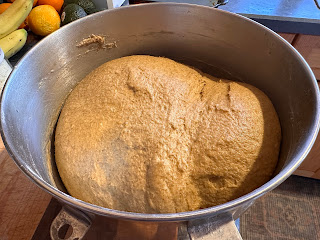Drawing by Vince Long © 2025
Diamond X opened on the west end of Billings a few years ago and as a restaurant and brewery it offers plenty of food options along with what it brews and, with a full license, they also feature a variety of cocktails. While I haven't eaten there, I did drop in to check out the beer offerings looking for what might make a great bread.
I was interested in their AMbear, an amber that promises "rich, toast & toffee maltiness" which sounded great but, alas, they were out. However, the nice server suggested their Engine #7, a Vienna lager, as a substitute and it was a worthy stand-in. It's a light colored brew but with a full mouth feel and a caramel flavor all the way through. As I sampled it, I envisioned it in an orange rye bread and knew it would make a perfect match.
The origin of this recipe is the "Fleischmann's Bake-It-Easy Yeast Book" from 1972. Back then there was an offer for it on the back of a package of yeast and I sent away for it for something like 50 cents. It is still one of my "go to" sources. With the exception of the beer replacing the water, this pretty much follows the original recipe in the book for "Orange Rye." It produces a very aromatic bread, especially the orange overtones, and is surprisingly light considering how much rye flour is used.
Ingredients
2-3/4 cups (1 pound, 7 ounces) (650 grams) Diamond X Engine #7 Vienna lager, at room temperature
2-1/2 teaspoons instant yeast
2 teaspoons kosher salt (if using regular salt, use a little less)
1/2 cup (3.5 ounces) (100 grams) dark brown sugar, packed
1/4 cup (2.9 ounces) (83 grams) dark molasses
3 tablespoons (1.6 ounce) (44 grams) margarine, softened
3 tablespoons (.7 ounce) (22 grams) orange peel, grated
3-1/2 cups (1 pound, .7 ounce) (472 grams) rye flour
3 cups (16.6 ounces) (462 grams) white bread flour
1 cup (5.5 ounce) (154 grams) additional white bread flour
Yield: 2 loaves
Procedure
Place the beer, yeast, salt, brown sugar, molasses, margarine, and orange peel in a mixer bowl and stir/mix together.
Add the rye flour and stir/mix until well combined.
Add the 3 cups of bread flour and mix on medium high for 2 minutes. As it thickens, switch to the dough hook on the mixer or turn the dough onto a floured board and begin the kneading process. Kneading options are explained on the front page. Add the additional cup of bread flour as necessary to obtain a dough that is not too soft. Knead until it becomes smooth. In my stand mixer this took about 7 minutes.
Give the top of the dough a light spray of oil then cover the bowl with plastic wrap. Let it ferment for about 2-3 hours or until it doubles in size.
Place the dough on a floured board and flatten it out to remove the gas. Divide it in two and shape into loaves. Place each loaf into a pan that has been misted with oil. Give each a light misting on their tops before covering them with plastic wrap.
Let them proof until about doubled. This took mine about 1 hour and 20 minutes.
Remove the plastic wrap and place the pans in a preheated over. The original recipe instructs to preheat to 375°F and to place the loaves on the lowest rack of the oven for 40 minutes. I use a convection over so I preheated to 350°F and baked on the middle rack for 40 minutes.
Check for doneness, remove from the pans, and cool on a wire rack.
Illustrations
The orange rind, grated.
Ingredients combined before adding the bread flour.
The kneading.
Kneading completed, getting ready for the fermentation step.
After rising.
Punched down to remove the gas, ready to shape into loaves.
The loaves ready to rise.
Out of the oven.
The crumb.
rich, toast & toffee maltiness, toast & toffee maltiness rich, toast & toffee maltin










No comments:
Post a Comment